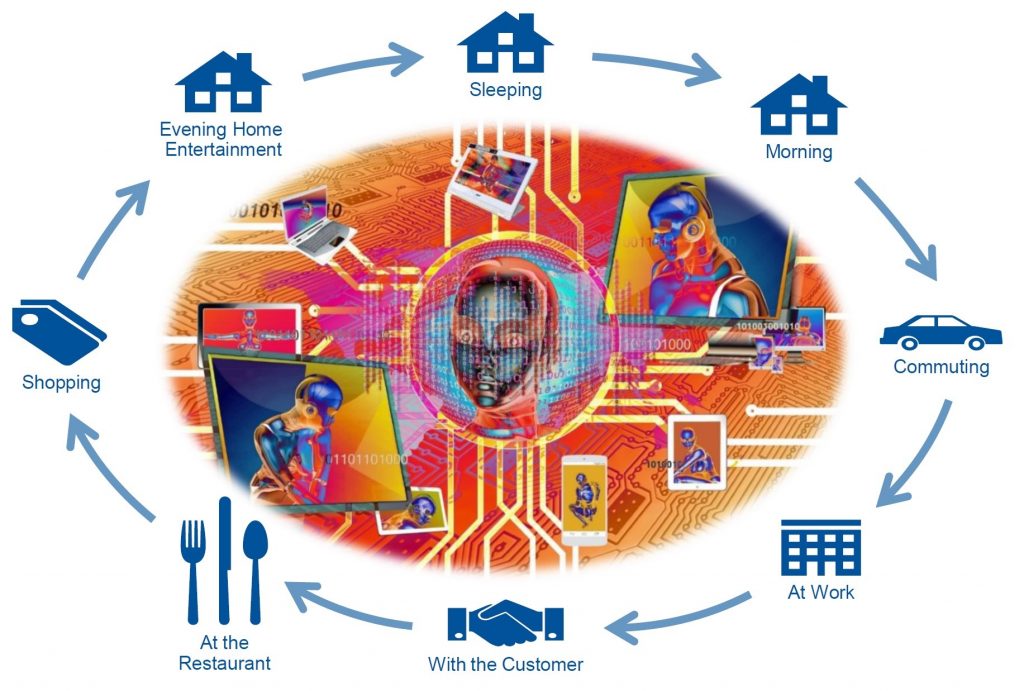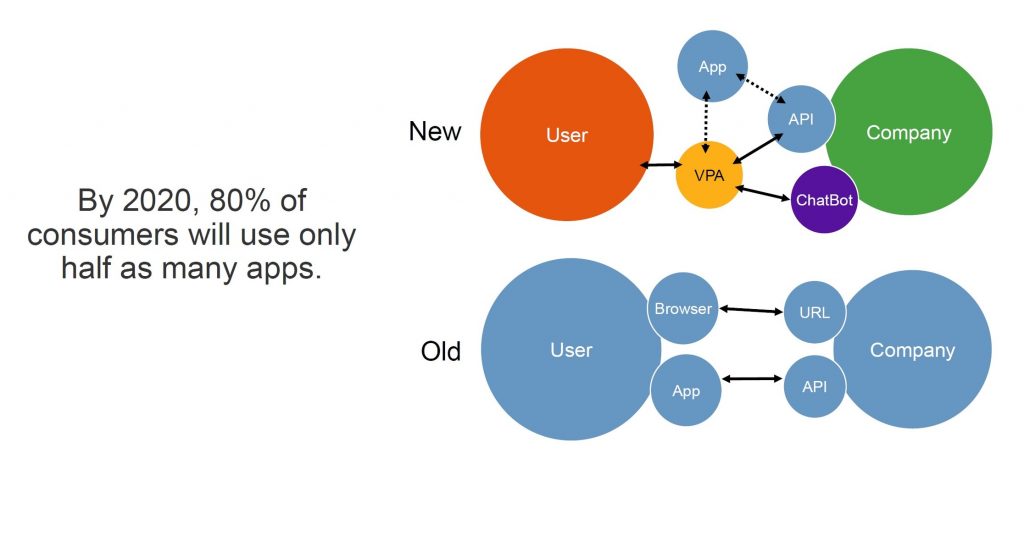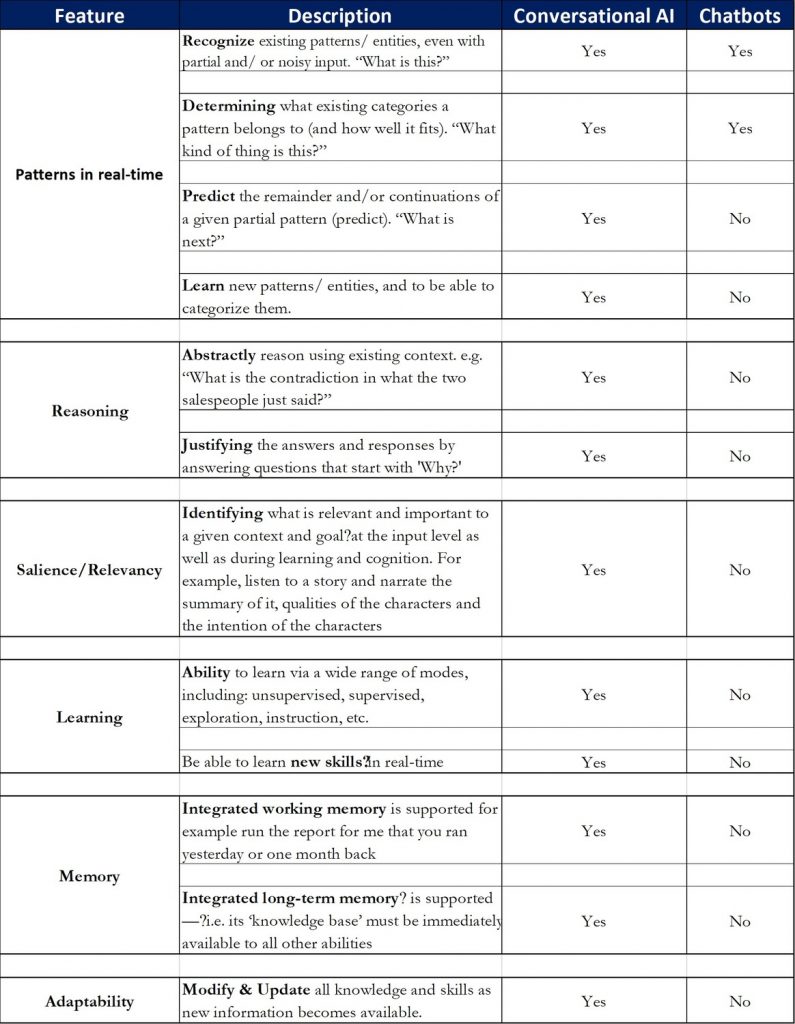Knowledge is knowing that a tomato is a fruit; Intelligence is not putting it in the fruit salad.
I think this quote sums up the fundamental difference between a Chatbot (Knowledge) and a Conversational AI (Intelligence) agent. While Knowledge is the collection of information and skills, Intelligence is the ability to apply the knowledge in a wide variety of situations.
As we enter into the ‘Age of Smart Machines‘ driven by Artificial Intelligence (AI), Internet Of Things (IoT), Data & Analytics, Robotics, Augmented & Virtual Reality (AR/VR), I thought of taking the time to delve into the beginnings and the current state of AI as I believe AI will have the most profound impact on our lives compared to any other technology in our lifetime.
First the Business Context:
As small and large companies race to capture the newly created Artificial Intelligence market of $300 Billion dollars by 2020 (forecast by Gartner, 2017), it’s important to understand the definitions, the background and different AI approaches, so enterprises can invest, implement and integrate AI technology to improve customer experience and beyond. Gartner also predicts that by 2019, AI services will cannibalize at least 30% of revenues from today’s market-leading companies. In fact, Venture Beat article from October 2016, says AI agents like Alexa, Siri, and M will create the first trillion-dollar company.
Definitions: AI is a set of computing algorithms and techniques used to perform tasks that otherwise would need human intelligence. Machine Learning (ML) is a sub-set of AI in which networked structures make predictions from data.Deep Learning (DL) is a sub-set of ML in which the computing model is changed by the data.
While AI sounds like the ultimate magic bullet with machine learning (ML), deep learning (DL), NLP, NLG etc to solve any/all problems, it becomes the proverbial hammer looking for nail if you start with the wrong questions such as
what AI technology should I bet on?
Everyone is investing in AI, am I getting left behind?
Do I need to learn all the jargons of AI?
Every enterprise needs to figure out how to solve business problems or enhance business value by leveraging AI technology and by asking the right question that sounds something like this:
How do I apply AI technology to solve my business problem or enhance my business value quickly, economically and permanently in a manner that is responsive to future change?
So what are the trends that are contributing to this $300 Billion dollar market by 2020? Two key trends that are identified are as follows:
First, Conversational AI is becoming integral part of personal and professional life.
Customer Experience (CX) is at the center of the Digital Transformation and Conversational AI significantly impacts & improves the customer experience. In other words,
Conversational AI is THE new UI.
Source: Gartner, June 2017

Secondly, People will use Virtual Private Assistants (VPA) more than Apps by 2020.
User interacts with the VPA and VPA interacts with the Chatbots & Apps to respond back to the user.
Source: Gartner, June 2017

Now a bit of background on AI:
The early days of artificial intelligence were guided by a common vision: understanding the full range of intelligent behavior observed in humans and reproducing it in computational systems.
Many researchers continued to share this vision until the 1980s and 1990s, at which point AI began to fragment into a variety of specialized sub-disciplines, each with far more limited objectives.
Rather than creating intelligent systems with the same breadth and flexibility as humans, most recent research has produced impressive but narrow idiot savants. ~ Pat Langley, Cognitive Scientist
Over several decades of trying and failing (badly), the original vision was largely abandoned. Nowadays, almost all AI work relates to narrow, domain-specific, human-designed capabilities. Powerful as these current applications may be, they are limited to their specific target domain and have very narrow (if any) adaptation or interactive learning ability as humans do. Most computer scientists who graduated after the mid 80’s only know AI from that much watered-down perspective.
Introducing AGI – Artificial General Intelligence:
Just after year 2000, with the advancement of software, hardware and cognitive theory, a handful of scientists felt that it is right time to rekindle the original AI vision of understanding the full range of intelligent behavior observed in humans and reproducing it in computational systems.
Three of those scientists, visionaries Shane Legg, Ben Goertzel and Peter Voss coined the term ‘AGI’ – Artificial General Intelligence to distinctively differentiate researchers, scientists, engineers & business executives who are working on ‘real AI’ different from the ‘narrow or weak AI’ that was and till date continues to be popular. So, what is the ultimate goal of AGI?
A computer system that matches or exceeds the real time cognitive (not physical, not computational) abilities of a smart, well-educated human. ~ Peter Voss, AGI Visionary
The Third Wave Of AI by the AGI Visionary Peter Voss
Cognitive abilities include but are not limited to: holding productive conversations; learning new commercial and scientific domains in real time through reading, coaching, experimentation, etc. just like humans would; understanding, reasoning, memorizing, applying existing knowledge and skills to new domains. For example, learning new professional skills, a new language (including computer languages), or even novel games. AGI needs a cognitive architecture that allows the system to mature organically unlike narrow or weak AI built for a specific purpose. Its important to understand the difference, as I believe that we need both AI and AGI to solve a number of problems.
With that understanding and background, let’s now focus on the differences between Conversational AI & Chatbots?
Here is a sampling of the differences between Conversational AI and Chatbots.
Conversational AI – is based on Cognitive Architecture, AGI oriented, generic in nature
Chatbots – is based on ML, DL techniques, narrow or weak AI oriented, purpose driven

Some of the examples of Chatbots include:
Amazon-Alexa, Apple-Siri, Baidu-Duer/Flow, Google – Assistant/Now, HTC – Sense Corporation, Microsoft-Cortana, Nuance-Nina, Samsung-Bixby/S Voice/Viv, Sony-Xperia Agent
Conversational AI can serve as the Universal User Interface by Humanizing Interactions with machines and systems using natural language abilities while ‘narrow or weak AI’ provides the inputs to the Conversational AI.
On narrow or weak AI, like Chatbots, here’s what Jeff Bezos said
“Much of what we do with machine learning happens beneath the surface. Machine learning drives our algorithms for demand forecasting, product search ranking, product and deals recommendations, merchandising placements, fraud detection, translations, and much more. Though less visible, much of the impact of machine learning will be of this type — quietly but meaningfully improving core operations.”
I truly believe that the two technologies are complementary and when they are combined effectively , they could enhance customer experience and add significant value to both the customer & the company.
I understand that AI field is evolving rapidly and I would love to hear your thoughts on this topic, especially the examples of the Conversational AI agents that fit the bill as described above with a promise to get to the Nirvana, which is fully achieving the goal of AGI at some point of time in the future.
References:
Artificial Intelligence Technologies Fuel Competition in User Experience by Gartner, 2017. The Cognitive Systems Paradigm by Patrick Langley. AGI Checklist from Medium.com by Peter Voss.

Srini Pagidyala is the Co-Founder of Aigo.ai
Aigo (say I-go) is a Revolution in Intelligent Assistants.
Aigo.ai is the Most Advanced Natural Language Interaction Platform built on human-mind like Cognitive Architecture. Aigo is at the forefront of the next wave of AI evolution ‘Conversational AI is the new UI’ .
If you found this article insightful, below are the links to some of my other articles.
- Is there a better way to conquer the Big Bad Disruptive Wolfpack?
- What no one tells you about Innovation & Growth?
- Going Digital? What does that even mean?
- Fail Faster, Fail Cheaper – Innovate or Be Disrupted
- Fail Faster, Fail Cheaper – The Framework
- Fail Faster, Fail Cheaper – Barriers & Benefits
- 5 Critical Success Factors – IoT Platform Adoption
- Top 5 Barriers to Digital Transformation
- Top 5 Benefits of Digital Transformation
- Re-imagine your Customer Experience
- To Re-imagine, Need to Rethink
- 3 Practical Ways to Separate Data Signals from Noise
- 10 Things For a Killer Board in the Digital Era
- What is the Job Of Your Product?
- Changing the Game w/ Smart Connected Products
- Redefining Mfg: Smart Connected Products
- A Prescriptive approach for Manufacturers
- Pursuit Of Greatness – A Story of Ants & Laddoos
